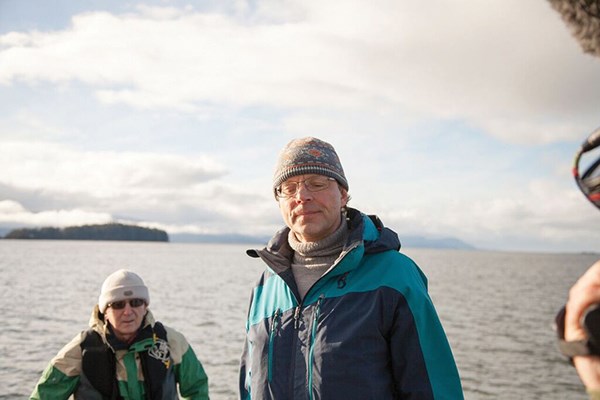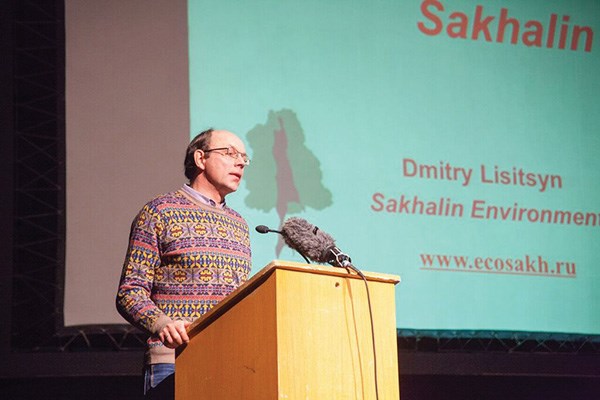Liquefied natural gas has created trouble for marine life. That was the message from a Russian delegation that stopped by Squamish over the weekend while on a tour of communities in B.C. slated for proposed LNG facilities.
The group met with My Sea to Sky members and others on Sunday at a Squamish restaurant. The four men – three scientists and a conservationist – were in B.C. to share what they say happened to salmon and other marine life near Sakhalin, the largest island in eastern Russia and home to Russia’s first operational LNG facility since 2009.
“We have the experience of the planning stage, the decision-making stage, the construction, post-construction and production stage,” said Dmitry Lisitsyn,
who is chairman of the Russian non-governmental organization Sakhalin Environment Watch.
Construction of the Sakhalin facility began in 2003. The men say the project contributed to the decimation of pink salmon runs in Sakhalin’s Aniva Bay even though the facility is 30 kilometres from the closest significant salmon river.
The area is also home to other oil and gas infrastructure including offshore oil and gas terminals and a processing plant. All told, the area has the world’s largest integrated oil and gas project, according to the Goldman Environmental Foundation.
Construction of the LNG facility and in particular the placing of the pipeline through a watershed significantly damaged the salmon stocks, said Lisitsyn, a conservationist who spoke on behalf of the delegation.
“Sedimentation blocks the oxygen supply to the eggs – this is the most critical type of impact,” he said.
The operational stage has less devastating impacts, but there is concern over the impact of tanker traffic, he said.
Before 2009, according to Lisitsyn, 27,400 metric tonnes of salmon were caught in Aniva Bay, since that year 5,000 metric tons are caught per year. The migration routes of the salmon also changed, he said.
“It switched,” he said. No one has studied why this happened, but Lisitsyn said the group is trying to organize an analysis to understand if tanker traffic is the cause.
While the delegation did not come specifically to discuss the Woodfibre LNG proposal, the group said the B.C. government should suspend plans to construct the project due to its potential impact on marine life such as herring.
“Herring is very, very sensitive,” Lisitsyn said.
Few studies have been done on the impact of low frequency noise from the tankers on marine life, he said.
“The fish are very sensitive to low frequency noise,” he said. “There are clear scientific data that salmon avoid noise polluted areas. It can change the salmon migration routes.”
Byng Giraud, Woodfibre LNG vice-president of corporate affairs, told The Squamish Chief there is really no comparing the project in Russia and even the Pacific Northwest LNG plant slated for northern B.C. to the facility planned for Howe Sound.
“Those notions of impact on salmon habitat, I don’t think they would apply,” he said.
In terms of tanker traffic, Giraud there has been shipping traffic to the Woodfibre site for more than 100 years.
“There were actually more barges and vessels when it was a pulp mill,” he said.

Woodfibre LNG plans to protect Mill Creek, the one creek on the site that has salmon, Giraud said.
“[We] plan to green it up to actually minimize impact,” he said. “Right now you’ve got contaminated soils and basically a concrete tube…. We’ll be cleaning that up.”
The SkeenaWild Conservation Trust, Skeena Watershed Conservation Coalition and Wild Salmon Center of Portland, Oregon invited the Russian group to North America.
Lisitsyn said prior to construction of the Sakhalin LNG plant, the surrounding community was almost unanimously in favour of the project.
“The contract was really profitable for local people… jobs and the revenue for local budgets,” he said.
Many of the construction jobs ultimately went to temporary foreign workers and there were few jobs available once the facility was operational, according to Lisitsyn.
Giraud said he does not imagine Woodfibre LNG needing to resort to temporary workers.
“We are 50 kilometres from a population of two million people, and frankly with the oil sands downturn, there is a lot of Canadian labour and expertise available,” he said.
The Woodfibre LNG proposal is currently in the midst of a three-week federal comment period, which ends March 1, on its possible upstream greenhouse gas emissions.
MP Pam Goldsmith-Jones is hosting a community meeting on the proposed Woodfibre LNG project on Saturday, Feb. 27 at 1 p.m. at the Eagle Eye Theatre in Squamish.
Federal Environment and Climate Change Minister Catherine McKenna is expected to make a final decision within a few months.



